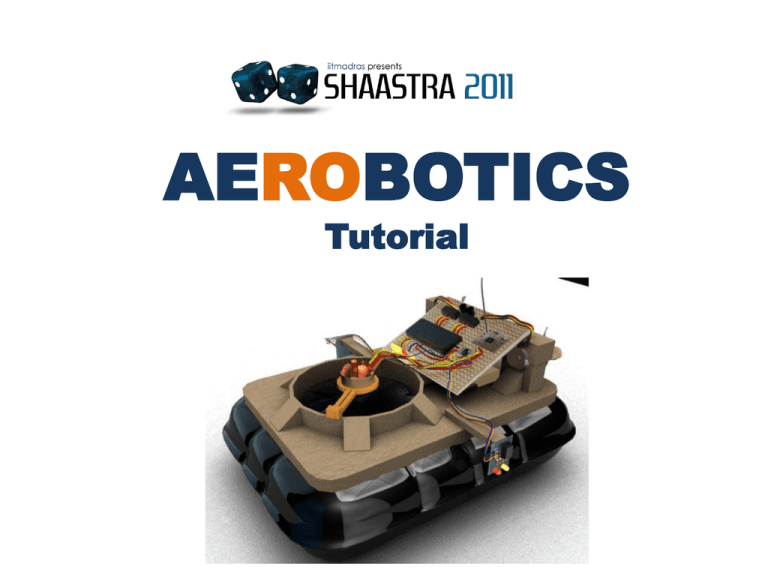AEROBOTICS AEROBOTICS
advertisement

AEROBOTICS Tutorial Introduction AEROBOTICS is an event which adds a vertical dimension to Robotics, making it all the more adventurous and challenging. The event aims to merge principles of aviation with those of robotics. AERO + robotics= Aerobotics AEROBOTICS AEROBOTICS TUTORIAL AEROBOTICS Arena AEROBOTICS Arena – various zones AEROBOTICS Hover-Craft AEROBOTICS HOVERCRAFT MATERIAL THRUST AND AIR CUSHION TORQUE & WEIGHT BALANCE DRIFTING & ROTATION NAVIGATION AEROBOTICS AEROBOTICS Another possible way by using a rudder…… AEROBOTICS AEROBOTICS Material • Considering the fact that the vehicle should be air borne it has to be light • Material should have good resistance to bending moments • The Material that can be considered to build the chassis could be -High/Medium Density Foam, depron -Balsa Wood • Cost of the material under consideration AEROBOTICS Thrust and Air cushion • The thrust to be provided depends on the weight of the Aerobot. • The static thrust of the motor can be lesser than the weight of the Aerobot. Primary importance is maintaining a good air-cushion to make the vehicle float. • This thrust can be provided by -Standard RC Brushless Motors -Duct-fans AEROBOTICS AEROBOTICS Duct Fan • Control by PWM • Simple DC Motor • High Power Requirements • Requires Large Current rating IC to control it. Relays can also be used. • Cost AEROBOTICS Torque & Weight balance Weight Distribution THRUST AEROBOTICS Placement • Placement of the components decides CG of the vehicle • The CG should be perfectly aligned with the Thrust line • Since the system is afloat it will experience some rogue torque caused by this misalignment of components • Too many actuators may also provide torque and add to the instability AEROBOTICS Placement Instability Moment Imbalance AEROBOTICS Drifting & Rotation • The system has an inherent property of drifting • This can only be controlled effectively by a good mechanical design of the system • Not all defects in the design can be countered by a electronic system • Rotation can however be regulated by an effective Control system • Rotation is due to the principle of Conservation of angular momentum AEROBOTICS Navigation • Horizontal thrust providers with control surfaces . Thrust provider can be fans or propellers For control surfaces we need to implement aerodynamically effective solutions which would be rudders • Rotatable horizontal thrust providers. • Can be implemented in either pusher or puller form AEROBOTICS Pusher • The horizontal thrust is being provided by a propeller placed at the rear end of the system • This means the bot is being pushed horizontally • There might be mismatch between the horizontal thrust line and the bot’s horizontal symmetry axis causing rotation and hence needs to be implemented carefully. CG AEROBOTICS Puller • The horizontal thrust is being provided by a propeller placed at the front end of the system • This means the bot is being pulled horizontally • The advantage in doing so is: in the case of mismatch the bot will still continue moving forward without rotation. CG AEROBOTICS Li-Poly POWER ESC SPECs AEROBOTICS Lithium Polymer Batteries • This is the most preferred Power pack used in RC Planes because of high power rating and duration longing. • Provides high current • One pack of Lipo Battery contains a group of cells in series, each cell can provide 3.7 V • Standard Specifications are 3 cell pack : 11.2 V AEROBOTICS Battery Specifications Factors to be considered before buying a battery: • Voltage • Ampere Hour Rating • No . Of Cells AEROBOTICS Electronics Sensors • IR sensor • LDR (Light Dependent Resistor) • Ultrasound Sensor (optional) Processor • Atmega • Arduino • PIC Actuator • Fans • Control Surfaces AEROBOTICS Sensors • Sensors are necessary to sense the lines on the arena and the side barricades. • The ideal sensors for this purpose will be IR sensors though a variety of sensors can be used. • IR sensors are cheap and decently reliable. AEROBOTICS Sensors • Light Dependent Resistor (LDR) has a property of changing its resistance when illuminated with light. • When placed in dark it has a very high resistance. Resistance drops dramatically when light falls on it. • It can be used to detect if the bulb is ON or OFF. AEROBOTICS LDR Sensor Circuit • In poor light conditions, Resistance of LDR is large and hence more potential drop. This increases the voltage at 3 more than that at 2. • Output voltage of the op-amp is HIGH and LED across 1 and 4 glows. • In bright light conditions due to lesser potential drop across LDR, output of op-amp would be LOW. LED across 8 and 1 glows. AEROBOTICS LDR Sensor Circuit •The circuit switches LED on in the dark •The LED remains off as long as LDR is illuminated •The 10K potentiometer shown can be used to adjust the sensitivity(calibration) of the sensor circuit •Transistor can be replaced with an op-amp as a comparator which was shown in the previous slide. AEROBOTICS Sensors • Ultra Sound Sensors can also be used to detect the walls on the sides. These are costlier than IR but more reliable. • The major challenge lies in placing the Optimal number of sensors in the right position • In the case when IR sensors are affected by the ambient light interference then TSOP sensors can be used. AEROBOTICS RF Communication • RF Communication can be used for controlling the hovercraft wirelessly. Methods to employ RF Communication RF Module Hacking open a RF toy car AEROBOTICS RF Module Transmitter Receiver • It consists of two parts • Transmitter • Receiver • The transmitter should be given serial data as input, which is received by the receiver AEROBOTICS RF Module We strongly recommend that you go through the following links:http://extremeelectronics.co.in/rf/rf-communicationbetween-microcontrollers-part-i/ http://extremeelectronics.co.in/avr-tutorials/rfcommunication-between-microcontrollers-part-ii/ http://extremeelectronics.co.in/avr-tutorials/rfcommunication-between-microcontrollers-%e2%80%93part-iii/ AEROBOTICS Hacking open a toy car • A cheap 4 channel RF controlled car maybe hacked open and used • The channels are independent so all the four channels can be directly used for controlling four movements of the hovercraft. •Since the channels are independent, upto 16 unique controls can be generated using various combinations of the channels if required. AEROBOTICS Processors • For onboard processing several processors are available in the market like microcontroller Arduino board Any other development board • An important specification of microcontroller is that it should have many PWM channels. • Development boards like Arduino Board provide an user friendly interface but it’s costlier than spare microcontroller. AEROBOTICS Brushless Motors Out runners High RPM Power Requirement ESC (Electronic Speed Controller) Control is via PWM (Pulse Width Modulation), following certain specifications Time Period = 20ms On time = 1 ms – 2 ms • Cost • • • • • AEROBOTICS Interfacing motor with microcontroller Processor ESC Motor AEROBOTICS Pulse Width Modulation • PWM is used to control the speed of the motor • This is done by controlling the ON time of the rectangular Voltage signal given to the motor Processor ESC Motor Driver Motor AEROBOTICS Motor Drivers • The current required to drive any motor is very high • Hence an appropriate motor driver is required For example L293D : max rating 1 amp L298 : max rating 2 amp Relays for high current duct fan. • The current by them may not be sufficient hence in such a case high Power Transistors can also be used. AEROBOTICS Problems that might surface Please keep the following aspects in mind :- • Hovercraft may drift outward at curves. • Natural tendency of the hovercraft to drift and rotate • Sufficient momentum might be required to climb the ramp • At the Y junction the hovercraft may tend to turn in one direction preferentially because of the angular momentum of the lift fan. AEROBOTICS Safety Issues • Consider your own safety. • Work carefully with propellers and brushless motors. Fix the motors properly on the chassis. • Be careful with LiPo, both while charging and working. Use according to specification by the manufacturer. AEROBOTICS Video links The following are some videos of RC hovercrafts that may be useful for you in building your own hovercraft:- • http://www.youtube.com/watch?v=y_tuFKtRSbs • http://www.youtube.com/watch?v=75xR_UgpUk&feature=related • http://www.youtube.com/watch?v=s1R4G9rwiP0 &NR=1 • http://www.youtube.com/watch?v=AFFXfjWW0F k&feature=related AEROBOTICS











